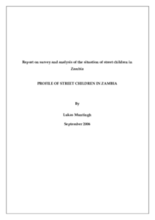This report presents a profile of street children interviewed by means of a structured questionnaire with a view to understand the problem better by gathering life style and life circumstances data. It should be emphasised that the data is not based on a census but on what can be defined as a sample of sufficient size to produce reliable data. It was a deliberate decision in the design of this project not to attempt a census as this would be too costly, too time consuming and would in all likelihood still produce results that can be questioned.
The emphasis in developing this profile was placed on generating information that would be useful for policy development. The aim is thus to identify and described trends in respect of the total group but also significant sub-groups. The survey conducted generated an enormous amount of data and this profile deals with the data on a national level, although all the variables presented can be analysed in terms of geographical location, gender and a range of other sub-sets. This data in its raw form remains available and should be regarded as a resource by service delivery agents to understand their own localities better.
Key findings of this profile study include:
-
There are an estimated 13,500 street children in Zambia; many more children are extremely vulnerable and may end up on the streets
-
Approximately 25% of children seen on the street during the day sleep on the streets at night
-
Very few street children are of foreign nationality
-
The most significant drivers of the street children population appear to be a complex of poverty, parental morbidity, lack of access to education, and limited alternatives
-
Children on the street are exposed to a wide range of risks and the majority have been victims of crime and / or forced to commit acts against their will
-
Less than half of the children knew of resources that were available to street children
-
More than 50 percent of children do not know what HIV/AIDS is
-
47 percent of the children stated that they had no where to go in case they needed help

